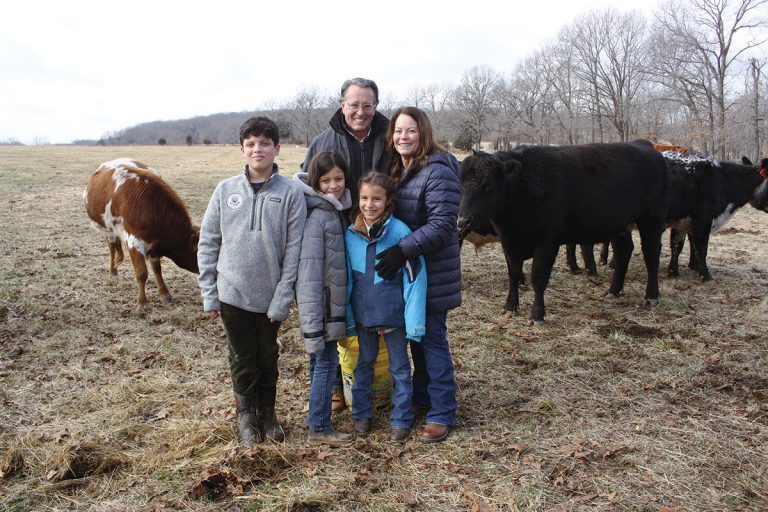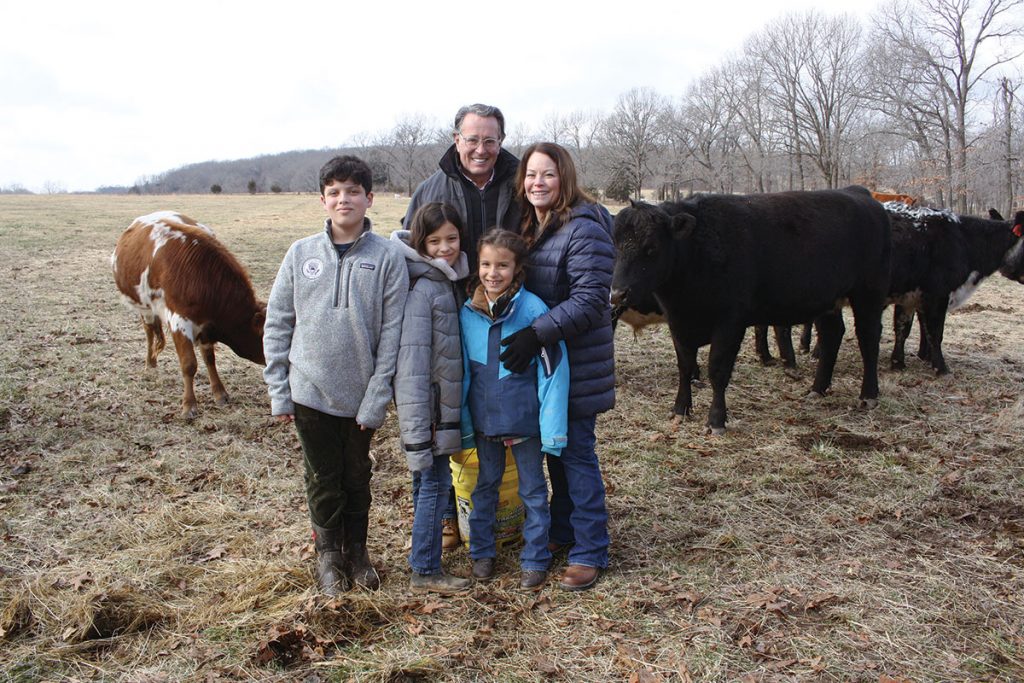

Buchen Beef utilizes DNA testing to produce top-quality beef for all tastes
Some cattle producers breed for color, others for EPDs. For Patrick and Susan Buchen, it’s all about the beef.
Patrick, a native of Illinois, is a sixth-generation cattle producer. His family still operates the farm his great-great-great-great-grandfather received in exchange for his service in the War of 1812.
“We have always had cattle,” Patrick said. “We always raised and processed our own until my grandfather started to use the local butcher in Bushnell, Ill. We built up a little meat business with the banker, teachers, our priest, and other people. I guess it was in our DNA.”
In 2016, after a career that led Patrick to the Shorthorn, Maine-Anjou and Texas Longhorn breed associations, and state fair management in Indiana and Illinois, he and Susan retired to the Ozarks from Texas, and are once again in the meat business.
Buchen Beef selects animals based on genetic markers for tenderness, marbling and quality grade.
The idea came to Patrick about 10 years ago after noticing Speckle Park cattle or Speckle crosses were winning carcass shows at the Calgary Stampede.
“My brothers and I started looking at why these Speckle calves were winning,” Patrick said. “The only thing we could determine is that the breeders were into measuring the leptin in the cattle.”
Leptin is a protein that regulates appetite, energy use, fat deposition and marbling. The higher leptin concentration means higher marbling and carcass quality. Cattle will have a base pair code of CC, TC or TT. The TT calves will typically deposit backfat faster and require fewer days on feed than TC or CC calves. Cattle with a homozygous TT tend to have higher marbling scores and gain weight quickly. Cattle with CC cattle tend to have a higher percentage of lean meat.
“Leptin either sends a signal to the brain, or it carries the protein to the brain to give it a signal,” Patrick explained. “In mammals, muscles get bigger when it breaks, tears and pulls apart and creates a pocket. Unrelated over here is leptin and it says, ‘Oh, we have a pocket.’ If it’s a leptin-TT, it sends a signal to the brain to fill that pocket with fat cells, thus the marbling. If it’s a leptin-CC, it tells the brain to fill that pocket with more muscle.”
Tenderness is tracked through three different enzymes: calpain 316, calpain 4751 and calpastatin. In a 1994 study at the Meat Animal Research Center in Clay Center, Neb., meat tenderness was measured by Warner-Bratzler shear force for tenderness score, juiciness and flavor intensity, and a scoring system was developed. Tenderness scores are expressed on a scale from 1 to 10. A score of 7 or higher is rated to have superior quality.
Utilizing testing by IGENITY™ L testing service, the Buchens send an ear clipping for a DNA profile for each animal. Data received from each animal is shared with customers to select the quality of beef they desire.
Because they are in the custom beef business, Susan said being able to offer their customers exactly the kind of meat they want is essential.
“We started thinking Prime was our only goal, but we realized some people don’t want that much fat,” she said. “With a leptin score and a tender score, we can cater to our customers’ taste and preferences.”
“The tender scores are very direct,” Patrick added. “We’ve eaten a 4, a 5, a 6 and a 9, and there is a difference in the taste of the meat. Some say if you feed a calf long enough, you will hit Prime, but you can’t do that. You can hit Prime with genetic markers.”
The Buchens experimented with extended feeding but were not pleased with the results, nor did the animal reach a Prime grade. At the age of 24 months, the steer was processed, and the result was an inch and half of backfat and the carcass barely graded Choice.
“It wasn’t in the DNA,” Susan said.
Tenderness scores and leptin-TT and -CC traits are not specific to a single breed and can vary tremendously from one animal to the next. However, Patrick added it does not appear the tenderness scores apply to Japanese cattle, the Wagyu and Akaushi breeds. The Buchens are currently experimenting with Akaushi genetics in their cattle, a small herd of various breeds, including Angus, Hereford, Gelbvieh and Speckled Parks. The couple has 10 head on feed for the beef program, with plans to bump up to 16 soon.
“I don’t put anything on feed that isn’t a tender score of at least 7. Some of those are CTs, a few CCs; most are TTs,” Patrick said. “We have had a leptin-TT and a tenderness of 7 that didn’t grade prime, but they are still delicious.”
One of the greatest challenges for the couple has been finding bulls that meet the criteria for their goals. Because they utilize an AI program, they are able to be selective in their breeding matches. Sometimes, however, it’s just pure luck.
“I bought out an older Angus breeder, his semen tank and all,” Patrick said. “There’s about 300 straws of semen, some from bulls that have been dead for 30 years. I’ve been sending semen in for testing and have found some real gems. There’s some bulls with TT-9 and TT-10 in there.”
The Buchens recently purchased a local custom processing facility, York Processing, in Humansville. Patrick said he feels now come “full circle” in the beef industry with the purchase.
“I’m dumbfounded how unintelligent I am about our industry once the hide comes off, yet that is the end product and what we should know better than anything,” he said.
Susan added the facility also allows them to offer processing to their beef customers and gives the customer the ability to receive truly custom processing.
When a customer purchases beef from the Buchens, Patrick and Susan ask for honest feedback.
“Our feedback from people who have just bought grocery store meat, they go nuts over it,” Susan said. “Farm-raised, hand-fed, corn-finished beef is just different.”
“We wanted that old-fashioned corn-fed taste,” she said.
A good nutrition program, Patrick said, is 80 percent of raising quality beef.
Cattle at Buchen Beef are fed in three phases. Calves start on a commercial 16-percent ration from a local mill, then moved to a 12-percent beef ration. Feed the final 120-days before processing consists of corn and supplements.
“My cattle are on full feed, if they want it, as soon as they want to go to a creep feeder,” Patrick said. “The average age kill is 16 months and we are processing at 13 months. There has been so much controversy and lack of information on what is the optimal age to harvest a calf. It’s misleading because if you look at Prime, the number one criteria is marbling, and the second is age. Yet, you have some people who say you can’t get to Prime until 24 months of age; but we know that isn’t true. Think about the economic impact of six more months of feeding. I’m comfortable standing up for my cattle at 12, 13 months and saying they are going to grade Prime, and consumers will get a youthful, tender piece of meat.”
Susan and Patrick feel the humane treatment of their animals is critical for the overall health.
“We treat them like pets,” Susan said. “We know they are going to be beef one day, but they are all treated very well.
In addition to off-the-farm sales, the Buchens have sold finished individuals through Wheeler Livestock Auction in nearby Osceola, Mo. The calf’s score is announced to potential bidders and the sale includes custom processing. By the time the gavel hit on the most recent Burchen Beef steer, with a tender score of 6 and leptin-TT, the bid was $2,800.
The Buchens admit some of their friends in the cattle industry have expressed doubts about their venture into superior beef via DNA, even Patrick’s own brothers had their doubts. Some, however, are now seeing it’s not all pixie dust.
“They are shaking their heads now when we are selling steers for $2,800,” Susan said.
Patrick added that he sees DNA analysis to improve the beef industry.
“If we were color blind and breed-neutral, we would be a much better industry,” he said. “I’ve said that for 50 years. I sit at the sale barn every week and they ask what I want. I want that great one. I see an animal I like, buy it and then we do the DNA. One of the problems today is that you have too many breeders who have bred only for EPDs. We need to look at the cattle for what they are, forget about the breed and the color, and get the best quality.”